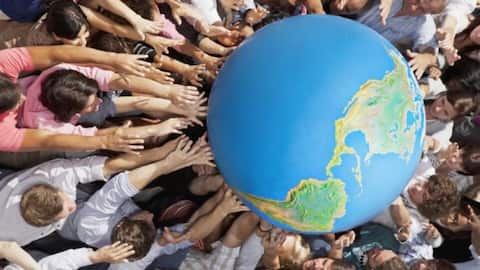World Population Day: How rising population is impacting climate change
What's the story
Climate change is mostly blamed on fossil fuels, deforestation, or overconsumption, but we rarely talk about how our ever-growing population quietly fuels these drivers. As the world population crosses eight billion, each new life adds to the demand for energy, land, and resources. On World Population Day, here's how population growth impacts our warming planet - and why it deserves more attention.
#1
Rising demand for energy
Every person added to the global population needs light, heat, transportation, and technology. As billions plug in phones, run air conditioners, and travel, the combined energy demand keeps climbing. Even renewable energy can't instantly match this surge. Countries expanding electrification and middle-class lifestyles mean more coal, gas, and oil consumption, which pushes carbon emissions higher. More people means more energy - and more emissions.
#2
Increased pressure on forests
Growing populations need land for homes, farming, and industry. This often comes at the cost of forests cleared for agriculture or urban expansion. Fewer trees means less carbon dioxide absorbed from the atmosphere. Deforestation also disrupts rainfall patterns and biodiversity, fueling further climate impacts.
#3
Strain on water and food systems
Feeding billions requires huge amounts of energy-intensive agriculture. High-yield farming relies on chemical fertilizers, irrigation pumps, and long supply chains. All this consumes fossil fuels and emits greenhouse gases. More mouths mean more meat, dairy, and processed foods - which come with big carbon footprints. Without smart planning, population growth can stretch food systems unsustainably, raising emissions and depleting precious water sources.
#4
Urban sprawl and infrastructure expansion
As cities expand to house growing populations, construction booms. Building new roads, apartments, and offices demands vast amounts of cement, steel, and energy - all high-carbon industries. Sprawling urban areas often increase car dependency, raising emissions further. Poorly planned cities also encroach on green spaces that act as carbon sinks. Without smart urban design, population growth can turn cities into hidden engines of emissions.
#5
Waste generation and pollution
A larger population naturally produces more waste - from household trash to industrial by-products. Landfills release methane, a potent greenhouse gas. More people also means more wastewater, plastics, and pollution entering rivers and oceans. Managing this waste sustainably is costly and complex. Left unchecked, it damages ecosystems and worsens climate impacts.
